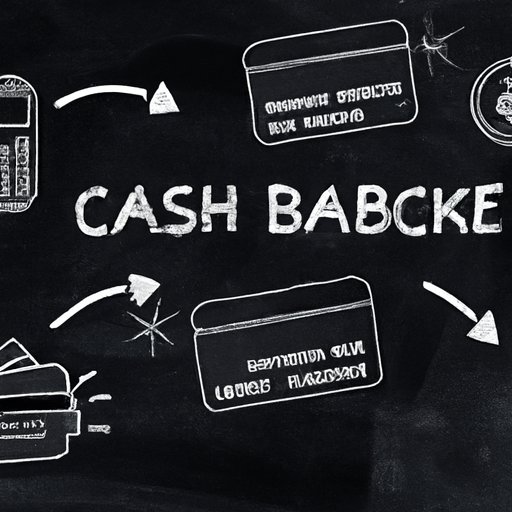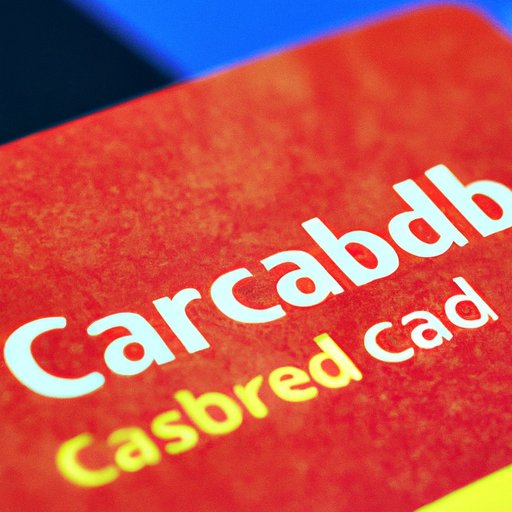Introduction
As a credit card user, you’ve probably heard about cashback rewards programs, where you can earn a percentage of the money you spend as a rebate on your credit card. If you’re new to the credit card world, the concept of earning money back on your purchases might seem too good to be true. However, cashback credit cards have become popular among consumers due to the considerable benefits they offer. This article aims to provide a comprehensive guide to cashback rewards programs, how they work and how to maximize their benefits.
Maximizing Your Credit Card Rewards: A Comprehensive Guide to Cashback
Benefits of using credit card cashback programs
The primary advantage of using cashback credit cards is that you get rewarded for your spending through cashback rewards. This reward can add up quickly if you use your credit card frequently. Furthermore, cashback rewards programs offer a variety of perks such as cashback bonuses, sign-up bonuses, and other incentives that can help you save money in the long run. By using cashback credit cards, you can earn money every time you make a purchase, even on your daily expenses.
Tips for maximizing your cashback rewards
One of the most effective ways to maximize your cashback rewards is to use your credit card for purchases you would normally make and pay the balance in full every month. This strategy will help you avoid interest rates, which can significantly reduce your rewards’ value. Additionally, many cashback credit cards offer higher cashback rates on specific categories purchases such as groceries, restaurants, and gasoline. So, you can take advantage of the card’s terms by strategically using it on the preferred categories.
Types of cashback programs
Several types of cashback rewards programs are available in the market. Some of these include point-based rewards, tiered rewards, flat-rate rewards, and rotating category rewards. Point-based rewards allow you to accrue points that can be redeemed for cashback or other incentives. Tiered rewards offer higher percentages on certain spending brackets. Meanwhile, flat-rate rewards offer the same percentage of cashback on all purchases. Finally, rotating category rewards offer higher percentages on certain categories of purchases that change quarterly. Choosing the best cashback program depends on your spending habits and the types of fees and benefits you’re looking for.
The Ins and Outs of Credit Card Cashback Programs
How cashback rewards are earned
The amount of cashback rewards you can earn varies by credit card and is usually based on a percentage of the total amount spent on purchases. For instance, a 1% cashback rate on a $100 purchase will result in $1 in cashback rewards. Some cards offer higher percentages of cashback rewards, while others are tiered based on the amount spent.
Methods of redemption
Redemption methods also vary by credit card. Some offer cash rebates to your account, while others offer gift cards, merchandise, or travel credits. However, you can only redeem rewards once you have accumulated a certain amount or after a certain period, depending on the card’s terms and conditions.
Types of cashback credit cards
Besides the different types of cashback programs mentioned earlier, several cashback credit card options are available in the market. Discover it Cash Back, Chase Freedom Flex, Amex Cash Magnet, and Citi Double Cash Card are among the most popular cashback credit cards. The different types of cards offer various rewards percentages, fees, and other incentives, so it’s essential to look at each card’s features carefully.
The Ultimate Guide to Understanding Credit Card Cashback
Understanding cashback percentages and tiers
The cashback percentage you receive depends on the credit card, which could range from 1% to 6% or more. Some cashback credit cards come with different tiered rates, offering higher percentages the more you spend during a billing cycle. Typically, the higher the spending threshold, the higher the percentage of cashback rewards you can earn.
How to calculate your potential rewards
In most cases, your credit card issuer will provide you with a cashback calculator to help you estimate your potential rewards. Alternatively, you can use this formula: expected cashback = (total purchase) x (cashback percentage). For example, if you spend $1,000, and your cashback is 1.5%, your expected cashback is $15.
Comparing cashback credit cards
Choosing the right cashback credit card for you can be a tricky task, but you can get the best deal by comparing different options. Look for the cards that offer high cashback rates on your regular purchases and add up the rewards percentages over time. Additionally, research each card’s fees and terms and conditions before applying.
Making Sense of Cashback: How Your Credit Card Rewards Program Really Works
The economics of cashback credit cards
Cashback rewards programs allow credit card companies to increase card usage and encourage spending. Additionally, these incentives attract more customers to use their credit cards, enabling card issuers to earn money from merchant fees and interest payments. Customers that carry balances on their cashback credit cards, often end up paying more money in interest than they receive in rewards, making issuing these cards a high-profit business for credit card companies.
How credit card companies make money from cashback programs
Credit card companies make money through two primary streams: merchant fees and interest payments. Merchant fees are fees that vendors pay to credit card companies to accept credit card payments. Credit card issuers charge merchants between 1% and 3% of the total purchase amount. Interest paid by customers carrying balances on their credit cards is the other primary revenue stream for credit card companies.
Risks and disadvantages of cashback credit cards
Although cashback credit cards can be an excellent way to save money, there are risks associated. Using a credit card to earn cashback rewards could lead to overspending, accumulating debt, and pay high-interest rates if you don’t pay your balance in full each month. Additionally, some cashback credit cards carry an annual fee that can eat into the rewards you earn. It’s essential to evaluate any potential risks or disadvantages before signing up for a credit card rewards program.

Get Paid to Spend: Exploring the World of Cashback Credit Cards
Examples of popular cashback credit cards
Discover it Cash Back is a popular cashback credit card that offers up to 5% cashback rewards on categories that rotate quarterly and 1% cashback on all other purchases. The Chase Freedom Flex card offers 5% back on rotating categories and 1% back on all other purchases. The Amex Cash Magnet card offers 1.5% cashback on all purchases. The Citi Double Cash Card offers a flat 2% cashback rate on all purchases.
Highlights of the rewards offered by these cards
Discover it Cash Back offers cashback rewards on everyday purchases, and the cashback bonus can be redeemed anytime. Chase Freedom Flex offers a sign-up bonus, purchase coverage, and extended warranty protection. Amex Cash Magnet offers introductory interest-free periods and purchase protection. Citi Double Cash Card offers no annual fee, no category restrictions, and easy redemption.
Factors to consider when choosing a cashback credit card
When selecting a cashback credit card, consider factors such as fees, reward rates, redemption options, and other perks such as sign-up bonuses. Additionally, think about your spending habits and ensure the card you choose aligns with your preferred categories and types of purchases. Finally, assess the interest rate for carrying balances and other costs before applying.
Understanding the Fine Print: What You Need to Know About Credit Card Cashback
Fees associated with cashback credit cards
Some cashback credit cards come with annual or monthly fees that can offset the cashback rewards. Additionally, other fees such as foreign transaction fees, late payment fees, and balance transfer fees may apply to your use of the card. It’s essential to review the card’s fees and ensure they align with your usage before applying.
How to avoid common pitfalls
One of the best ways to avoid common pitfalls is to pay your balance in full each month, which will help you maximize your rewards and avoid interest charges. Additionally, maintain a careful eye on your spending and only use your credit card for purchases within your budget. Keep track of your spending by signing up for mobile alerts and automatic payment services.
Reading the terms and conditions of your card carefully
Reading the terms and conditions of your credit card before signing up is vital to understanding the features, benefits, fees, and restrictions associated with the rewards program. Ensure you’re aware of any introductory offers or sign-up bonuses, redemption options, interest rates, and other fees.
Cashback Deconstructed: Unlocking the Secrets of Credit Card Rewards
Common misconceptions about cashback credit cards
One of the most common misconceptions about cashback credit cards is that they hurt your credit score. However, this is not true. Using your credit card responsibly, paying your bills on time, and maintaining a reasonable credit utilization rate will only help your credit score. Additionally, many consumers believe that high cashback percentages automatically indicate the best value. However, it’s essential to review the other card features, fees and redemption options not to get distracted by a card with high cashback value.
Strategies for earning more rewards
One strategy for increasing rewards is to use the card for regular purchases and the low-interest rate cards for more significant expenses or balances. You can also maximize your rewards by using cashback credit cards that offer higher percentages on specific categories. Additionally, activating sign-up bonuses, taking advantage of promotions, and redeeming rewards often can help you earn more cashback rewards.
Final thoughts and takeaways
Cashback credit cards can be a great way to save money on everyday expenses and earn rewards for your spending. However, it’s essential to review and compare the various types of cashback programs, fees, restrictions, and benefits before signing up. Using your cashback credit card wisely and paying attention to your spending habits will enable you to unlock the full financial benefits of cashback rewards programs.
Conclusion
Understanding cashback credit card rewards programs is crucial for maximizing the benefits of your credit cards. By following these tips and tricks, you can get the most out of your cashback rewards. Always evaluate the terms and conditions of your card and the fees associated with it before applying. Finally, use your cashback credit card responsibly and pay attention to your spending habits and balances.
Apply for the best cashback credit card and start earning rewards for your daily expenses today.
(Note: Is this article not meeting your expectations? Do you have knowledge or insights to share? Unlock new opportunities and expand your reach by joining our authors team. Click Registration to join us and share your expertise with our readers.)
